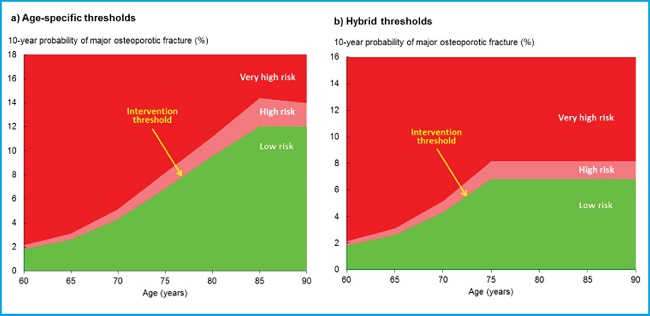Meu SciELO
Serviços Personalizados
Journal
Artigo
Indicadores
-
 Citado por SciELO
Citado por SciELO -
 Acessos
Acessos
Links relacionados
-
 Citado por Google
Citado por Google -
 Similares em
SciELO
Similares em
SciELO -
 Similares em Google
Similares em Google
Compartilhar
Revista de Osteoporosis y Metabolismo Mineral
versão On-line ISSN 2173-2345versão impressa ISSN 1889-836X
Rev Osteoporos Metab Miner vol.15 no.3 Madrid Jul./Set. 2023 Epub 08-Mar-2024
https://dx.doi.org/10.20960/revosteoporosmetabminer.00015
LETTER TO THE EDITOR
Refining the categorization of osteoporotic fracture risk
AECE Research Group. The Association of Clinical Endocrinologists of Ecuador. Guayaquil, Ecuador
Dear Editor,
The right categorization of the risk of osteoporotic fracture is essential if we want to effectively direct our efforts in the prevention and management of individuals with osteoporosis at risk of fractures. In the article published by Lopez Gavilánez et al. in Revista de Osteoporosis y Metabolismo Mineral (ROMM) in 2022 (1), the implementation of intervention thresholds (age-specific and hybrid) in the Ecuadorian population is discussed based on an estimate of the risk of fracture using the country-specific FRAX tool. The rate of individuals above the intervention threshold (high risk) and thus eligible for treatment reached 2 %, while those eligible for bone density study and subsequent risk re-calculation reached 74 %. These rates increased when the hybrid threshold was used. A total of 31 % of women qualified for treatment and 76.3 % for bone mineral density study (1).
The UK National Osteoporosis Guidelines Group (NOGG) categorized the risk of fracture as low and high using fracture probability estimated using the FRAX tool (2). The use of these thresholds resulted in an underestimation of the risk of fracture in older age groups, leading McCloskey to suggest the use of a hybrid threshold with age-dependent intervention thresholds up to 70 years and a fixed threshold thereafter with a single fracture probability up to 90 years (2). Back in 2019, the NOGG guidelines refined the categorization of risk of fracture into “high” and “very high” to optimize treatment selection (anabolic or antiresorptive) in high-risk patients (3). The high-risk category would now be in the probability of fracture above the intervention threshold but below the upper assessment threshold. The low-risk category would remain below the intervention threshold level (4). Using this risk re-categorization, the number of women characterized as very high risk increased with age.
Adopting the methodology used by the NOGG (5), the European guidelines (3), and IOF-ESCEO (4) for risk category refinement, our group implemented the new thresholds to re-categorize the risk of fractures as high and very high in the same population of 2283 women studied by Lopez Gavilanez et al. back in 2022 (1). With age-specific thresholds, we found that 33 (1.4 %) and 12 (0.5 %) women were categorized as high- and very high-risk, respectively. However, with the hybrid threshold, 148 (21.4 %) and 69 (10 %) women were categorized as high- and very high-risk, respectively (Fig. 1). When both intervention thresholds were compared, the number of high- and very high-risk women selected increased by 4.5 times and 5.8 times, respectively.

Figure 1. Fracture risk categories based on intervention thresholds. The high-risk category would now fall above the intervention threshold but below the upper assessment threshold. The low-risk category would remain below the intervention threshold level (4). Using age-specific thresholds, 33 and 12 participants were categorized as high- and very high-risk women, while with the hybrid threshold, 148 and 69 participants were categorized as high- and very high-risk women.
The addition of re-categorization into high and very high risk to the national osteoporosis guidelines will positively impact treatment selection by physicians in the countries of the region.
BIBLIOGRAFÍA/REFERENCES
1. Lopez Gavilanez E, Valdivieso Jara J, Imaicela Naula L, Cedeño German R. Eficacia clínica de los umbrales de intervención híbridos y dependientes de la edad basados en FRAX en la población ecuatoriana. Rev Osteoporos Metab Miner 2022;14(2):74-81 DOI:10.4321/S1889-836X2022000200003 [ Links ]
2. McCloskey E, Kanis JA, Johansson H, Harvey N, Oden A, Cooper A, et al. FRAX-based assessment and intervention thresholds–an exploration of thresholds in women aged 50 years and older in the UK. Osteoporos Int 2015;26:2091-9. DOI:10.1007/s00198-015-3176-0 [ Links ]
3. Kanis JA, Cooper C, Rizzoli R, Reginster J-Y;Scientific Advisory Board of the European Society for Clinical and Economic Aspects of Osteoporosis (ESCEO) and the Committees of Scientific Advisors and National Societies of the International Osteoporosis Foundation (IOF). European guidance for the diagnosis and management of osteoporosis in postmenopausal women. Osteoporos Int 2019;30(1):3-44. DOI:10.1007/s00198-018-4704-5 [ Links ]
4. Kanis JA, Harvey NC, McCloskey E, Bruyère O, Veronese N, Lorentzon M, et al. Algorithm for the management of patients at low, high and very high risk of osteoporotic fractures. Osteoporos Int 2020;31(1):1-12. DOI:10.1007/s00198-019-05176-3 [ Links ]
5. Compston J, Cooper A, Cooper C, Gittoes N, Gregson C, Harvey N, et al. UK clinical guideline for the prevention and treatment of osteoporosis. Arch Osteoporos 2017;12(1):43. DOI:10.1007/s11657-017-0324-5 [ Links ]











 texto em
texto em 


